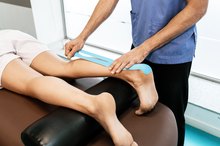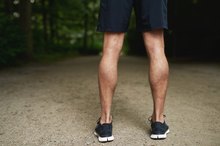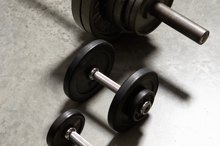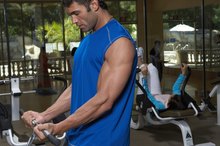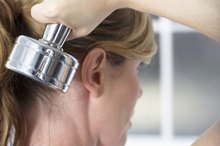The Pain in My Right Calf Hurts More When I Squat
There are two muscles in the back of the lower leg or calf that, if injured, can produce pain when you squat. Squatting stretches those muscles because your foot is flexed upward. Injury to those muscles is called a strain and the severity of the injury determines treatment and the length of healing time.
Muscles Involved
The two muscles in the back of the calf are the gastrocnemius and the soleus. The gastrocnemius is the larger of the two and is the more visible. It is the valentine-shaped muscle just below your knee. You use this muscle to straighten your foot when you point your toes. The other muscle is the soleus and it is a deeper, smaller muscle. It also is used to point your foot downward.
- The two muscles in the back of the calf are the gastrocnemius and the soleus.
- The other muscle is the soleus and it is a deeper, smaller muscle.
Identifying the Right Muscle
Symptoms of a Torn Calf Muscle
Learn More
The gastrocnemius starts above the knee and inserts into the heel. The soleus starts on the back of your lower leg bone, the tibia, and inserts onto your heel. When you squat, you are bending your knee so you are actually taking some stress off the gastrocnemius. No strain is taken off the soleus, so pain that occurs when you squat is most likely due a strain of the soleus muscle.
- The gastrocnemius starts above the knee and inserts into the heel.
- The soleus starts on the back of your lower leg bone, the tibia, and inserts onto your heel.
Severity
Muscle strains are graded on a scale of 1 to 3, with 3 being the most severe. With a grade 1 strain, only 10 percent or less of the fibers of the muscle are torn. With a grade 2 the percentage is between 10 and 50 percent. With a grade 3, it is 50 percent or more. A grade 1 may only be a slight tightness or tenderness over the injured area. Usually grade 3 strains will require crutches or a cane to walk.
- Muscle strains are graded on a scale of 1 to 3, with 3 being the most severe.
- With a grade 2 the percentage is between 10 and 50 percent.
Treatment
Hyperextension of the Calf
Learn More
Initial treatment for a strain is ice and rest. You can elevate that leg to help reduce any swelling. You may also use a compression sleeve wrap to reduce inflammation and add some stability to the injured area. Light stretching and strengthening should begin as soon as you can tolerate it. You can talk to a sports chiropractor or a physical therapist for a rehabilitative program. A massage therapist who specializes is sports massage can also help with reduction of pain and minimizing scarring in the muscle.
- Initial treatment for a strain is ice and rest.
- You can elevate that leg to help reduce any swelling.
Related Articles
References
- SportsInjuryClinic.net: Calf Strain
- Honeine JL, Schieppati M, Gagey O, Do MC. The functional role of the triceps surae muscle during human locomotion. PLoS One. 2013;8(1):e52943. doi:10.1371/journal.pone.0052943
- Binstead JT, Varacallo M. Anatomy, bony pelvis and lower limb, calf. [Updated 2019 Apr 5]. In: StatPearls. Treasure Island (FL): StatPearls Publishing; January, 2019.
- Uhl JF, Gillot C. Anatomy of the veno-muscular pumps of the lower limb. Phlebology. 2015;30(3):180-93. doi:10.1007/s00276-008-0333-6
- Douketis JD. Deep Venous Thrombosis (DVT). Merck Manual Professional Version. Updated March, 2018.
- Petruska A. Calf Strain. Boston Sports Medicine and Research Institute.
- Bryan Dixon J. Gastrocnemius vs. soleus strain: how to differentiate and deal with calf muscle injuries. Curr Rev Musculoskelet Med. 2009;2(2):74-7. doi:10.1007/s12178-009-9045-8
- Prakash A, Entwisle T, Schneider M, Brukner P, Connell D. Connective tissue injury in calf muscle tears and return to play: MRI correlation. Br J Sports Med. 2018;52(14):929-933. doi:10.1136/bjsports-2017-098362
Writer Bio
Greg Cooper began writing in 2007 with his book "The Reasonable Radical." He completed undergraduate work at West Virginia University and received his Doctor of Chiropractic from Sherman College. Cooper taught spinal manipulation in orthopedic hospitals in China and was part of a sports medicine team for the 1992 Olympic trials.
